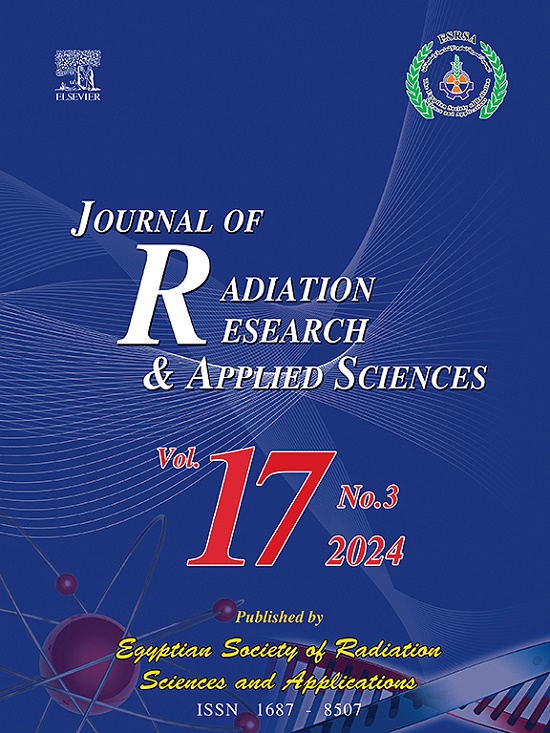Impact of nonlinear thermal radiation on peristaltic pumping of different shaped nanoparticles of copper in curved wavy channel
IF 1.7
4区 综合性期刊
Q2 MULTIDISCIPLINARY SCIENCES
Journal of Radiation Research and Applied Sciences
Pub Date : 2025-03-13
DOI:10.1016/j.jrras.2025.101359
引用次数: 0
Abstract
The main objective of this research is to investigate the experimental [28] verified correlations of the thermophysical characteristics of copper nanoparticles of different shapes that are incorporated in the equations. It is a vital mechanism in many physiological processes, including blood circulation and digestion. The rhythmic contractions and relaxations of a tube define this biological phenomenon. This study investigates the electrical conducting nanofluids flow in a curved channel in the presence of natural convection. Furthermore, the different shapes of copper nanoparticles, such as spheres, blades, and platelets, are examined. A modification of the energy equation is accomplished by the use of viscous dissipation, joule heating, and nonlinear thermal radiation. The modelled equation of the problems is a highly nonlinear partial differential equation. These equations are converted into nonlinear dimensionless ordinary differential equations by using dimensional variables, assuming a small Reynolds number, and a long wavelength. The numerical technique is employed in Mathematica via NDSolve to obtain the results. Results indicate that platelet-shaped nanoparticles have a substantial influence on temperature, pressure, and velocity compared to spherical and blade-shaped nanoparticles. For the platelet-shaped nanoparticle, the nonlinear thermal radiation and Hartmann number exhibit opposite behavior for fluid and heat flow.
非线性热辐射对弯曲波浪形通道中不同形状铜纳米颗粒蠕动泵送的影响
本研究的主要目的是研究不同形状的铜纳米粒子的热物理特性的实验验证相关性,并将其纳入方程中。它是许多生理过程的重要机制,包括血液循环和消化。管的节律性收缩和松弛定义了这种生物现象。本文研究了导电纳米流体在自然对流条件下弯曲通道中的流动。此外,还研究了不同形状的铜纳米颗粒,如球体、叶片和血小板。利用粘性耗散、焦耳加热和非线性热辐射对能量方程进行了修正。该问题的模型方程是一个高度非线性的偏微分方程。利用量纲变量,假设雷诺数小,波长长,将这些方程转化为非线性无量纲常微分方程。在Mathematica软件中使用NDSolve进行数值计算。结果表明,与球形和叶片状纳米颗粒相比,血小板状纳米颗粒对温度、压力和速度的影响更大。对于片状纳米粒子,非线性热辐射和哈特曼数在流体和热流中表现出相反的行为。
本文章由计算机程序翻译,如有差异,请以英文原文为准。
求助全文
约1分钟内获得全文
求助全文
来源期刊

Journal of Radiation Research and Applied Sciences
MULTIDISCIPLINARY SCIENCES-
自引率
5.90%
发文量
130
审稿时长
16 weeks
期刊介绍:
Journal of Radiation Research and Applied Sciences provides a high quality medium for the publication of substantial, original and scientific and technological papers on the development and applications of nuclear, radiation and isotopes in biology, medicine, drugs, biochemistry, microbiology, agriculture, entomology, food technology, chemistry, physics, solid states, engineering, environmental and applied sciences.
 求助内容:
求助内容: 应助结果提醒方式:
应助结果提醒方式:


